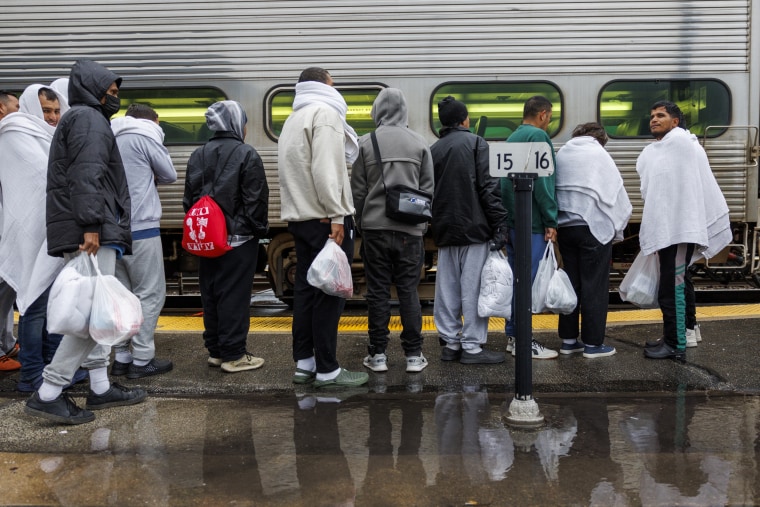Republican National Convention delegates erupted in applause last month when Texas Gov. Greg Abbott doubled down on his commitment to send buses full of migrants to blue cities.
“We have continued busing migrants to sanctuary cities all across the country,” Abbott told the cheering crowd in Milwaukee. “Those buses will continue to roll until we finally secure our border.”
But the buses have not been rolling on a consistent basis for months because of a steep drop in the number of migrants apprehended at the southern border, according to officials and migrant shelter operators in Texas and in a half-dozen big cities across the U.S.
Roughly 117,000 migrants were stopped in May, down from a record 300,000 in December. In June, the number dropped even further — to about 84,000, the lowest monthly total since President Joe Biden took office in 2021.
“They now come much less frequently,” said Josh Goldfein, a staff attorney for the Legal Aid Society of New York, “because they don’t have enough people to cross the border to fill up a bus.”
White House officials and immigration advocates attribute the slowdown to an enhanced crackdown on U.S.-bound migrants by Mexican authorities and Biden’s executive action in June restricting who can claim asylum at the southern border.
A spokesman for Abbott acknowledged that there were now fewer migrants to bus out of state, but said that it was the governor’s actions in Texas that fueled the drop in migrants crossing the border.
“Texas has decreased illegal crossings into the state by 85% thanks to our historic border mission,” the spokesman, Andrew Maheris, said. “Fewer illegal crossings into Texas means there are fewer buses departing for sanctuary cities.”

Abbott started busing in 2022 as part of Operation Lone Star, an $11 billion program designed to address the migrant surge in Texas.
Large numbers of migrant buses rumbled out of the border towns of Del Rio and McAllen last year. But it has been several months since a single bus has left either of the two cities, local officials and migrant shelter operators told NBC News.
The last buses sponsored by Abbott to leave Laredo and Brownsville rolled out in January, according to people familiar with the issue. And the number of buses leaving El Paso has fallen off sharply in the past few months, according to two nonprofits that serve migrants.
“The opportunity exists for buses every Wednesday if the need is there,” said Bill Irvin, of the nonprofit Opportunity Center for the Homeless. “And honestly, I have not had the need to use those buses from here for six to eight weeks. But that shows you how low the census has become amongst all of the shelters here in El Paso.”
A spokesperson for the Texas Division of Emergency Management, which has managed bus logistics in the past, said bus departures have fluctuated over time “due to the number of individuals processed and released by the federal government in overwhelmed border communities, which have an impact on passenger numbers.”
“The season/weather conditions seem to have an impact as well,” the spokesperson added in an email.
But officials in multiple cities that had been receiving buses in the past said none have arrived from Texas since January.
The last bus to reach Philadelphia arrived on Dec. 17 with 29 people from Del Rio, Texas, according to a spokesperson with the city’s Office of Immigrant Affairs.

No Abbott buses have arrived in Washington, D.C., this year, according to a person familiar with the influx. None are believed to have rolled into Los Angeles since Jan. 20, according to Joseph Riser, of the county’s office of emergency management. And he said that bus was carrying only 18 people.
“They came pretty sparsely loaded,” he said.
Denver last received a bus arranged by Abbott’s office in June, according to a city official. A bus arrived in a Chicago suburb that same month, but none has rolled into the city of Chicago since Christmas, officials said.
Chicago is set to host the Democratic National Convention next week. A spokesperson for the mayor’s office said the city isn’t expecting an influx of new arrivals but is making preparations just in case.
And in New York, the buses largely stopped arriving after Mayor Eric Adams imposed restrictions on them in December and filed a lawsuit in January against 17 bus companies that were bringing migrants to the city from Texas.
Instead, the buses had been dropping off migrants in New Jersey, where they were given train tickets to Manhattan. But even those buses mostly stopped in June after Biden signed his executive action, according to immigration activist Power Malu, who took a leading role in welcoming migrants to the city.
He coordinated his efforts in New York with a network of immigration advocates in Texas via a chat group on an encrypted app. “We always knew when the buses were coming,” said Malu, who runs the grassroots organization Artists-Athletes-Activists.
Malu noted that while the buses from Abbott made headlines, much of the flow into New York during the historic migrant surge was through airports and migrants paying for their own bus tickets.
Local officials in Texas border towns say the lack of migrants coming across the border has caused some shelters to recalibrate.
Victor Trevino Jr., who works as an attorney for the mayor of the city of Laredo, said, “We’re even getting NGOs now having to downsize because of the lack of intakes.”